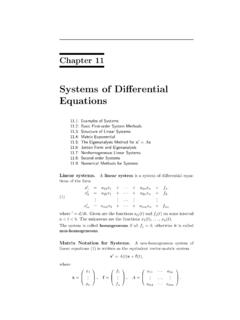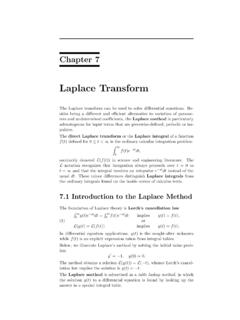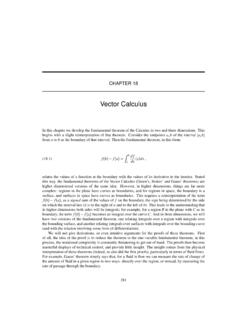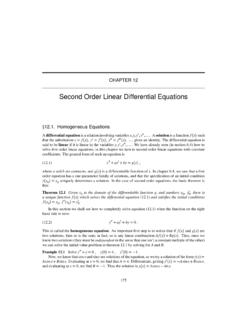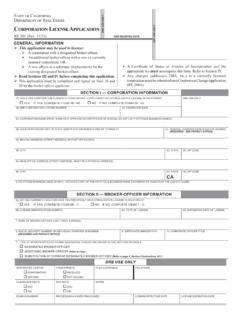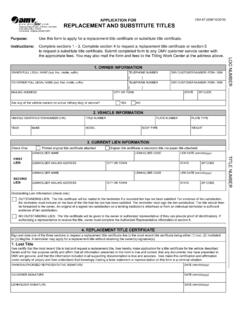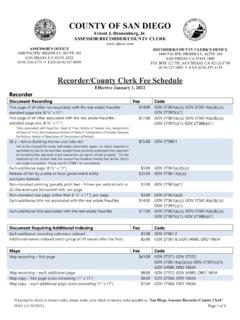Transcription of 7.4 Cauchy-Euler Equation - University of Utah
1 Cauchy-Euler EquationThe differential equationanxny(n)+an 1xn 1y(n 1)+ +a0y= 0is called theCauchy-Eulerdifferential Equation of ordern. The sym-bolsai,i= 0, .. , nare constants andan6= Cauchy-Euler Equation is important in the theory of linear differ-ential equations because it has direct application toFourier s methodin the study of partial differential equations . In particular, the secondorder Cauchy-Euler equationax2y +bxy +cy= 0accounts for almost all such applications in applied second argument for studying the Cauchy-Euler Equation is theoret-ical: it is a single example of a differential Equation with non-constantcoefficients that has a known closed-form solution.
2 This fact is due to achange of variables (x, y) (t, z) given by equationsx=et, z(t) =y(x),which changes the Cauchy-Euler Equation into a constant-coefficient dif-ferential Equation . Since the constant-coefficient equations have closed-form solutions, so also do the Cauchy-Euler 5 ( Cauchy-Euler Equation )The change of variablesx=et,z(t) =y(et)transforms the cauchy -Eulerequationax2y +bxy +cy= 0into its equivalent constant-coefficient equationaddt(ddt 1)z+bddtz+cz= result is memorized by the general differentiation formulaxky(k)(x) =ddt(ddt 1) (ddt k+ 1)z(t).
3 (1)Proof:The equivalence is obtained from the formulasy(x) =z(t), xy (x) =ddtz(t), x2y (x) =ddt(ddt 1)z(t)by direct replacement of terms inax2y +bxy +cy= 0. It remains to establishthe general identity (1), from which the replacements Cauchy-Euler Equation551 The method of proof is mathematical induction. The induction step uses thechain rule of calculus, which says that fory=y(x) andx=x(t),dydx= identity (1) reduces toy(x) =z(t) fork= 0. Assume it holds for a certainintegerk; we prove it holds fork+ 1, completing the us invoke the induction hypothesis LHS = RHS in (1) to writeddtRHS=ddtLHSR everse the chain ,dx/dt= (xky(k)(x)) Expand with = (kxk 1y(k)(x) +xky(k+1)(x))Apply the product +xk+1y(k+1)(x)Usexky(k)(x) = +xk+1y(k+1)(x)Use hypothesis LHS= the resulting Equation forxk+1y(k+1).
4 The result completes the details, which prove that (1) holds withkreplaced byk+ 1:xk+1y(k+1)=ddtRHS kRHS=(ddt k)RHS=(ddt k)ddt(ddt 1) (ddt k+ 1)z(t)=ddt(ddt 1) (ddt k)z(t)1 Example (How to Solve a Cauchy-Euler Equation )Show the solution detailsfor the equation2x2y + 4xy + 3y= 0,verifying general solutiony(x) =c1x 1/2cos( 52ln|x|)+c2e t/2sin( 52ln|x|).Solution: The characteristic Equation 2r(r 1) + 4r+ 3 = 0 can be obtainedas follows:2x2y + 4xy + 3y= 0 Given differential (r 1)xr 2+ 4xrxr 1+ 3xr= 0 UseEuler s substitutiony= (r 1) + 4r+ 3 = + 2r+ 3 = 0 Standard quadratic 12 52iQuadratic formula complex Substitution.
5 The second step is to usey(x) =z(t) andx=etto transform the differential Equation . By Theorem 5,2(d/dt)2z+ 2(d/dt)z+ 3z= 0,a constant-coefficient Equation . Because the roots of the characteristic equation2r2+ 2r+ 3 = 0 arer= 1/2 5i/2, then the euler solution atoms aree t/2cos( 52t), e t/2sin( 52t).Back-substitutex=etandt= ln|x|in this Equation to obtain two independentsolutions of 2x2y + 4xy + 3y= 0:x 1/2cos( 52ln|x|), e t/2sin( 52ln|x|).Substitution Details. Becausex=et, the factore t/2is written as (et) 1/2=x 1/2.
6 Becauset= ln|x|, the trigonometric factors are back-substituted likethis: cos( 52t)= cos( 52ln|x|).General Solution. The final answer is the set of all linear combinations ofthe two preceding independent Equation . Find solu-tionsy1,y2of the given homogeneousdifferential Equation which are inde-pendent by the Wronskian test, +y= + 4y= + 2xy +y= + 8xy + 4y= 0 Variation of Parameters. Find a so-lutionypusing a variation of parame-ters = = + 9y= sec + 9y= csc 3x
